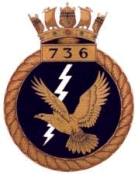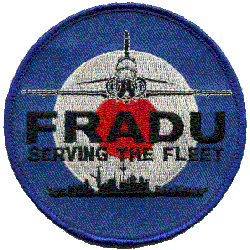|
The Fleet Requirements & Air Direction Unit (FRADU) - RNAS Yeovilton
The first Hawks to officially enter Fleet Air Arm service were both T.1s; XX175 and XX311, and they arrived at RNAS Yeovilton on 6th April 1994. A further four examples arrived at Yeovilton over the following two days, as the six T.1s were integrated into the FRADU fleet and operated alongside the remaining serviceable Hunter airframes. Each Hawk was subsequently issued with a FRADU fleet number that were at the time not in use with the Hunter fleet; '861', '865', '866', '867', '868' and '869', although these were not applied to the actual airframes. All six airframes were painted in the RAF training colour scheme of red and white with a blue painted spine and fin, and aside from two airframes, had the last three digits of its serial applied under the cockpit. A seventh Hawk T.1, XX242 arrived in May 1994, as FRADU began to operate an established mixed Hawk/Hunter fleet on taskings.
Over the remaining months of 1994, further RAF training policy changes took place, which in turn freed up further potential airframes for the Royal Navy. The surviving FRADU Hawker Hunter airframes were at this time halfway through a thorough maintenance/overhaul programme, that was being carried out by Lovaux Ltd at Hurn (now Bournemouth Airport) under contract to the Fleet Air Arm. This process would extend the type's service life until the end of the century. With the prospect of further Hawk airframes becoming available in the short term, the decision was made to cancel the contract and bring the Hunter's retirement forward to April 1995.
As a result, Hawker Hunter GA.11 XE689/864 would become the last to emerge from the process in November 1994.
On 9th December, an official FRADU Hunter 'retirement' flypast took place over Yeovilton, flying over major airfields in the South West of England, including RNAS Culdrose, RAF Chivenor and RNAS Portland.
On 31st December 1994, FRADU's active fleet consisted of 15 airframes; 8 Hawker Hunters and 7 Hawks, with two Hunter airframes held in store at Yeovilton.
On 6th February 1995, two more Hawk airframes, both finished in air defence grey colours, arrived at Yeovilton, with five further examples (2 grey and 3 black) following by the end of the month. The Hunters were withdrawn on a one-to-one basis and ferried to RAF Shawbury for storage and imminent disposal from the Fleet Air Arm. By the time the fifteenth and final Hawk, T.1A XX286 had arrived for the FRADU on 19th May 1995, there was just one Hunter left at RNAS Yeovilton; GA.11 XF300/860 which itself departed for storage a few weeks later.
The FRADU was now a BAe Hawk T.1/T.1A equipped unit.
FRADU on the move
During the mid-1990s, the Royal Navy conducted a review of its Air Stations, and at its conclusion the closure of two airfields was announced; RNAS Lee-on-Solent (HMS Daedalus) in Hampshire, and RNAS Portland (HMS Osprey) in Dorset.
The latter was home to the Flag Officer Sea Training (FOST), and the waters around the base were used for Operational Sea Training exercises for all surface ships, submarines and Royal Fleet Auxiliaries of the Royal Navy. The FRADU, operating from RNAS Yeovilton, provided airborne missile threat and high speed attack simulations using both the Hunter and Hawk platforms for these exercises. Following the airfield closure announcement, it was announced that FOST would relocate to Plymouth (HMS Drake), and the exercise areas would also move to the surrounding waters.
In January 1995, it was announced that FRADU would relocate from RNAS Yeovilton to be closer to the new FOST base.
Moves to the former RAF Chivenor and current RAF St Mawgan airfield were considered, but it was decided to move the Unit to RNAS Culdrose (HMS Seahawk) in Cornwall. FOST formally moved to Plymouth in the summer of 1995, and the FRADU Hawk airframes were gradually moved to Culdrose during November that year. By 1st December, FRADU was fully operational at its new base.
Gradually the FRADU Hawk fleet were refinished into RAF gloss black training livery, after major servicing had been completed on each of the airframes at RAF St Athan.
Initially the Hawks were also adorned with gold Fleet Air Arm wings on the tail fin, and white ROYAL NAVY lettering on the rear fuselage, above the airframe serial number.
During 1998/99 FRADU, now operated by Hunting Contract Services, lost the majority of its original Hawk airframes, as each were gradually ferried back to RAF St Athan to take part in the Hawk Fuselage Replacement Programme (FRP).
Replacement airframes were of course provided from RAF stocks, but these were placed on loan to the Fleet Air Arm, not officially transferred.
A similar airframe swap took place in 2002/3, which saw some of the original Hawk airframes returned to Culdrose. On this occasion, ROYAL NAVY lettering was applied underneath the serial number, rather the traditional "above it" arrangement as seen in the past.
The third major airframe shuffle occurred in 2008/09, as Hawks at FRADU (which was then run by Serco Defence, Science and Technology) were exchanged with examples formally based at RAF Valley and RAF Leeming.
From that date, all FRADU Hawks were to be operated in plain black livery without any additional lettering present aside from its serial number. However, in March 2009 permission was granted for seven FRADU airframes to be given special Fly Navy 100 anniversary markings.
Up until June 2013, FRADU was operated by Babcock International Group PLC under contract to the Royal Navy, and it operated fifteen Hawk airframes (3 T.1, 1 T.1W and 11 T.1As) from RNAS Culdrose, prior to its stand down, and the standing up of 736 Naval Air Squadron.
Navy Flying Standards Flight (Fixed Wing) / Yeovilton Hawk Detachment
One of the two other operators of the Hawk in Fleet Air Arm service, before June 2013, was the Navy Flying Standards Flight (Fixed Wing) - NFSF(FW) at RNAS Yeovilton.
This Unit was formed in 1944 and has operated several types including the Airspeed Oxford, de Havilland Tiger Moth and Vampire, and the Hawker Sea Fury. In 1956, the Unit moved to RNAS Yeovilton and became a part of the Station Flight, and four years later became its association with the Hawker Hunter. During 1972, NFSF(FW) began to lodge with the FRADU, sharing the use of its Hunters.
Its association with the Hawk began with the FRADU at RNAS Yeovilton in 1994, as the type began to enter Royal Navy service replacing the Hunters. NFSF(FW) moved with FRADU to RNAS Culdrose in December 1995, before it returned to RNAS Yeovilton in 1997. As a result of the move, two FRADU Hawks were placed on detachment from Culdrose, and used to maintain pilot currency of the Fleet Air Arm's fighter pilots, and flying assessments for rotary wing pilots wishing to convert to fast jets.
The Unit, which was renamed the RNAS Yeovilton Hawk Detachment in mid-2012, did not have any allocated airframes, instead the FRADU rotated its entire fleet between Culdrose and Yeovilton.
2013 - the future of Royal Navy Hawk operations
On 6th June 2013, 736 Naval Air Squadron (736NAS) was re-commissioned at RNAS Culdrose, replacing both the Fleet Requirements & Direction Unit (FRADU) and Yeovilton Hawk detachment. The airframes are maintained by civilian engineers contracted by Babcock, and its aircrew is a mixture of both Royal Navy and civilian personnel, the latter of which are under contract to Serco.
736NAS was first formed at RNAS Yeovilton in May 1943 as the School of Air Combat, and was equipped with Seafire Mk.1Bs. Itís purpose was to teach the latest air combat techniques to experienced naval aviators. Following moves to St Merryn and then RNAS Culdrose in 1950, it operated numerous aircraft types, such as the Miles Masters, Fairey Barracudas, Supermarine Seafires, and Fairey Fireflies.
At its peak, it had a fleet of nearly 50 Hawker Sea Fury airframes in 1950, and this type continued in service until its disbandment two years later.
Reformed as an advanced Jet Flying School a day later, it operated such types as the Supermarine Attacker, Sea Vampire and Sea Hawk throughout the 1950s. The Supermarine Scimitar (1959-65), and Blackburn Buccaneer (1965-1972) were its final platforms until the Unit was disbanded in February 1972.
Today, the Squadron provides airborne threat simulations, allowing realistic training at sea, and also represents the central hub of Royal Navy Fast-Jet aviation during the transition to the Queen Elizabeth class aircraft carriers, and its Joint Lightning Force (JLF) fleet of aircraft.
|
![Hawk T.1 XX242 during May 1994, the first full month of FRADU Hawk operations [© Richard Parkhurst]](tmb/thawk242.jpg)
[© Richard Parkhurst]
![The FRADU dispersal, December 1994 [© Philip Shean]](tmb/thuntawk.jpg)
[© Philip Shean]
![The FRADU hangar, summer of 1995 [© Dave Burrow]](tmb/thangar.jpg)
[© Dave Burrow]
![Hawk T.1 XX178 with ROYAL NAVY applied underneath the serial, March 2005 [© author]](tmb/txx178rn.jpg)
[© author]
![Hawk T.1A XX316 operating in plain black livery, April 2011 [© author]](tmb/txx316xx.jpg)
[© author]
![Hawk T.1A XX261 resplendent in Fly Navy 100 livery, 2009 [© Andy Sheppard]](tmb/tflynavy.jpg)
[© Andy Sheppard]
![Two NFSF(FW) Hawks depart for a sortie out of RNAS Yeovilton, July 2008 [© author]](tmb/tnfsffw.jpg)
[© author]

|


